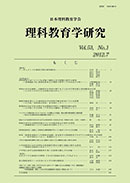Volume 50, Issue 3
Displaying 1-17 of 17 articles from this issue
- |<
- <
- 1
- >
- >|
Review Paper
-
2010Volume 50Issue 3 Pages 1-14
Published: March 03, 2010
Released on J-STAGE: June 30, 2022
Download PDF (1628K)
Original Papers
-
2010Volume 50Issue 3 Pages 15-25
Published: March 03, 2010
Released on J-STAGE: June 30, 2022
Download PDF (2222K) -
2010Volume 50Issue 3 Pages 27-41
Published: March 03, 2010
Released on J-STAGE: June 30, 2022
Download PDF (1897K) -
2010Volume 50Issue 3 Pages 43-56
Published: March 03, 2010
Released on J-STAGE: June 30, 2022
Download PDF (1545K) -
2010Volume 50Issue 3 Pages 57-66
Published: March 03, 2010
Released on J-STAGE: June 30, 2022
Download PDF (1512K) -
2010Volume 50Issue 3 Pages 67-76
Published: March 03, 2010
Released on J-STAGE: June 30, 2022
Download PDF (1023K) -
Experimental Studies on Better Understanding Factor That Students Gain from the "Self-made Textbook"2010Volume 50Issue 3 Pages 77-90
Published: March 03, 2010
Released on J-STAGE: June 30, 2022
Download PDF (3625K) -
2010Volume 50Issue 3 Pages 91-100
Published: March 03, 2010
Released on J-STAGE: June 30, 2022
Download PDF (1316K) -
2010Volume 50Issue 3 Pages 101-107
Published: March 03, 2010
Released on J-STAGE: June 30, 2022
Download PDF (722K) -
2010Volume 50Issue 3 Pages 109-116
Published: March 03, 2010
Released on J-STAGE: June 30, 2022
Download PDF (967K) -
2010Volume 50Issue 3 Pages 117-125
Published: March 03, 2010
Released on J-STAGE: June 30, 2022
Download PDF (1303K) -
2010Volume 50Issue 3 Pages 127-134
Published: March 03, 2010
Released on J-STAGE: June 30, 2022
Download PDF (1027K) -
2010Volume 50Issue 3 Pages 135-143
Published: March 03, 2010
Released on J-STAGE: June 30, 2022
Download PDF (1148K) -
2010Volume 50Issue 3 Pages 145-154
Published: March 03, 2010
Released on J-STAGE: June 30, 2022
Download PDF (1218K)
Note
-
2010Volume 50Issue 3 Pages 155-160
Published: March 03, 2010
Released on J-STAGE: June 30, 2022
Download PDF (1040K) -
2010Volume 50Issue 3 Pages 161-165
Published: March 03, 2010
Released on J-STAGE: June 30, 2022
Download PDF (1188K) -
2010Volume 50Issue 3 Pages 167-171
Published: March 03, 2010
Released on J-STAGE: June 30, 2022
Download PDF (605K)
- |<
- <
- 1
- >
- >|
